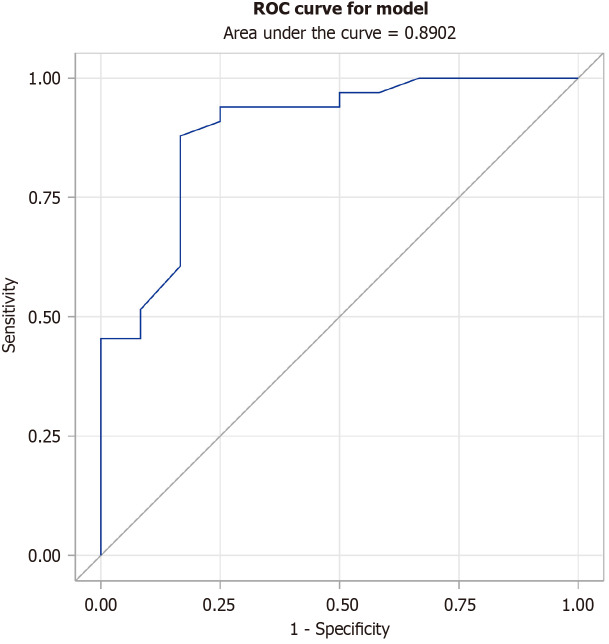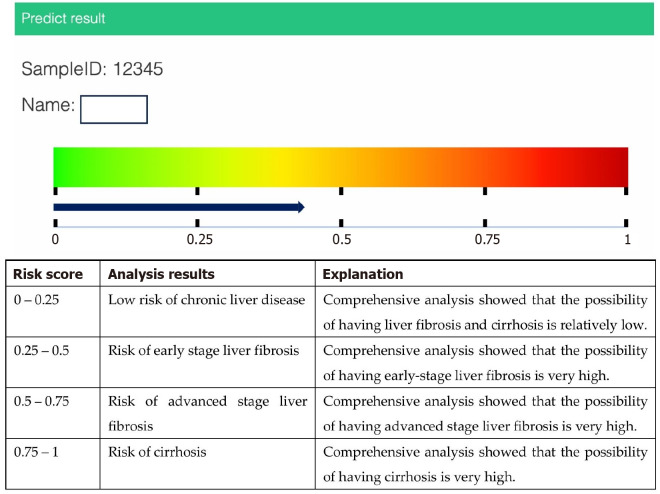Fernando Siguencia, Michitaka Matsuda, Vijay Pandyarajan, Sunao Tanaka, Steven M Smith, Catherine Bresee, Ekihiro Seki, Charles J Rosser, Hideki Furuya
下载PDF
{"title":"肝FibraChek Dx©的诊断性能,这是一种基于血液的无创检测肝硬化和肝癌的方法。","authors":"Fernando Siguencia, Michitaka Matsuda, Vijay Pandyarajan, Sunao Tanaka, Steven M Smith, Catherine Bresee, Ekihiro Seki, Charles J Rosser, Hideki Furuya","doi":"10.4254/wjh.v17.i6.106481","DOIUrl":null,"url":null,"abstract":"<p><strong>Background: </strong>Metabolic dysfunction-associated steatotic liver disease (MASLD), hepatic fibrosis, and cirrhosis are major risk factors for hepatocellular carcinoma (HCC), yet current blood-based diagnostic assays lack sufficient accuracy for routine clinical use. Identifying a non-invasive molecular signature that accurately detects liver disease could improve early diagnosis and monitoring. We hypothesized that the Liver FibraChek Dx<sup>©</sup> serum assay could discriminate MASLD and HCC from healthy controls using a multiplex biomarker-based algorithm.</p><p><strong>Aim: </strong>To evaluate the diagnostic performance of the Liver FibraChek Dx<sup>©</sup> assay for detecting MASLD and HCC.</p><p><strong>Methods: </strong>This was a prospective, single-center study conducted in a United States tertiary care setting. Serum samples were collected from 45 participants (14 MASLD, 19 HCC, 12 healthy controls) with liver histology confirmed by biopsy. The Liver FibraChek Dx<sup>©</sup> algorithm integrates weighted values of aspartate aminotransferase, alanine aminotransferase, taurocholic acid, L-tyrosine, platelet count, and patient age to generate a risk score. Wilcoxon rank sum tests were used to assess associations with histologic diagnosis, and receiver operating characteristic (ROC) curves quantified diagnostic performance.</p><p><strong>Results: </strong>Liver FibraChek Dx<sup>©</sup> risk scores were significantly elevated in MASLD and HCC compared to controls (median: 6.92 ± 3.86 <i>vs</i> 3.61 ± 1.67, <i>P</i> < 0.001). The area under the ROC curve was 0.890 (95%CI: 0.776-1.000) for distinguishing diseased from healthy individuals. Sensitivity was 93.9%, specificity 75.0%, positive predictive value 91.1%, negative predictive value 81.8%, and overall accuracy 88.9%.</p><p><strong>Conclusion: </strong>The Liver FibraChek Dx<sup>©</sup> assay accurately detects liver disease and shows promise as a non-invasive tool for diagnosing and monitoring MASLD and HCC.</p>","PeriodicalId":23687,"journal":{"name":"World Journal of Hepatology","volume":"17 6","pages":"106481"},"PeriodicalIF":2.5000,"publicationDate":"2025-06-27","publicationTypes":"Journal Article","fieldsOfStudy":null,"isOpenAccess":false,"openAccessPdf":"https://www.ncbi.nlm.nih.gov/pmc/articles/PMC12210174/pdf/","citationCount":"0","resultStr":"{\"title\":\"Diagnostic performance of Liver FibraChek Dx<sup>©</sup>, a blood-based test for the non-invasive detection of liver cirrhosis and cancer.\",\"authors\":\"Fernando Siguencia, Michitaka Matsuda, Vijay Pandyarajan, Sunao Tanaka, Steven M Smith, Catherine Bresee, Ekihiro Seki, Charles J Rosser, Hideki Furuya\",\"doi\":\"10.4254/wjh.v17.i6.106481\",\"DOIUrl\":null,\"url\":null,\"abstract\":\"<p><strong>Background: </strong>Metabolic dysfunction-associated steatotic liver disease (MASLD), hepatic fibrosis, and cirrhosis are major risk factors for hepatocellular carcinoma (HCC), yet current blood-based diagnostic assays lack sufficient accuracy for routine clinical use. Identifying a non-invasive molecular signature that accurately detects liver disease could improve early diagnosis and monitoring. We hypothesized that the Liver FibraChek Dx<sup>©</sup> serum assay could discriminate MASLD and HCC from healthy controls using a multiplex biomarker-based algorithm.</p><p><strong>Aim: </strong>To evaluate the diagnostic performance of the Liver FibraChek Dx<sup>©</sup> assay for detecting MASLD and HCC.</p><p><strong>Methods: </strong>This was a prospective, single-center study conducted in a United States tertiary care setting. Serum samples were collected from 45 participants (14 MASLD, 19 HCC, 12 healthy controls) with liver histology confirmed by biopsy. The Liver FibraChek Dx<sup>©</sup> algorithm integrates weighted values of aspartate aminotransferase, alanine aminotransferase, taurocholic acid, L-tyrosine, platelet count, and patient age to generate a risk score. Wilcoxon rank sum tests were used to assess associations with histologic diagnosis, and receiver operating characteristic (ROC) curves quantified diagnostic performance.</p><p><strong>Results: </strong>Liver FibraChek Dx<sup>©</sup> risk scores were significantly elevated in MASLD and HCC compared to controls (median: 6.92 ± 3.86 <i>vs</i> 3.61 ± 1.67, <i>P</i> < 0.001). The area under the ROC curve was 0.890 (95%CI: 0.776-1.000) for distinguishing diseased from healthy individuals. Sensitivity was 93.9%, specificity 75.0%, positive predictive value 91.1%, negative predictive value 81.8%, and overall accuracy 88.9%.</p><p><strong>Conclusion: </strong>The Liver FibraChek Dx<sup>©</sup> assay accurately detects liver disease and shows promise as a non-invasive tool for diagnosing and monitoring MASLD and HCC.</p>\",\"PeriodicalId\":23687,\"journal\":{\"name\":\"World Journal of Hepatology\",\"volume\":\"17 6\",\"pages\":\"106481\"},\"PeriodicalIF\":2.5000,\"publicationDate\":\"2025-06-27\",\"publicationTypes\":\"Journal Article\",\"fieldsOfStudy\":null,\"isOpenAccess\":false,\"openAccessPdf\":\"https://www.ncbi.nlm.nih.gov/pmc/articles/PMC12210174/pdf/\",\"citationCount\":\"0\",\"resultStr\":null,\"platform\":\"Semanticscholar\",\"paperid\":null,\"PeriodicalName\":\"World Journal of Hepatology\",\"FirstCategoryId\":\"1085\",\"ListUrlMain\":\"https://doi.org/10.4254/wjh.v17.i6.106481\",\"RegionNum\":0,\"RegionCategory\":null,\"ArticlePicture\":[],\"TitleCN\":null,\"AbstractTextCN\":null,\"PMCID\":null,\"EPubDate\":\"\",\"PubModel\":\"\",\"JCR\":\"Q2\",\"JCRName\":\"GASTROENTEROLOGY & HEPATOLOGY\",\"Score\":null,\"Total\":0}","platform":"Semanticscholar","paperid":null,"PeriodicalName":"World Journal of Hepatology","FirstCategoryId":"1085","ListUrlMain":"https://doi.org/10.4254/wjh.v17.i6.106481","RegionNum":0,"RegionCategory":null,"ArticlePicture":[],"TitleCN":null,"AbstractTextCN":null,"PMCID":null,"EPubDate":"","PubModel":"","JCR":"Q2","JCRName":"GASTROENTEROLOGY & HEPATOLOGY","Score":null,"Total":0}
引用次数: 0
引用
批量引用
Diagnostic performance of Liver FibraChek Dx© , a blood-based test for the non-invasive detection of liver cirrhosis and cancer.
Background: Metabolic dysfunction-associated steatotic liver disease (MASLD), hepatic fibrosis, and cirrhosis are major risk factors for hepatocellular carcinoma (HCC), yet current blood-based diagnostic assays lack sufficient accuracy for routine clinical use. Identifying a non-invasive molecular signature that accurately detects liver disease could improve early diagnosis and monitoring. We hypothesized that the Liver FibraChek Dx© serum assay could discriminate MASLD and HCC from healthy controls using a multiplex biomarker-based algorithm.
Aim: To evaluate the diagnostic performance of the Liver FibraChek Dx© assay for detecting MASLD and HCC.
Methods: This was a prospective, single-center study conducted in a United States tertiary care setting. Serum samples were collected from 45 participants (14 MASLD, 19 HCC, 12 healthy controls) with liver histology confirmed by biopsy. The Liver FibraChek Dx© algorithm integrates weighted values of aspartate aminotransferase, alanine aminotransferase, taurocholic acid, L-tyrosine, platelet count, and patient age to generate a risk score. Wilcoxon rank sum tests were used to assess associations with histologic diagnosis, and receiver operating characteristic (ROC) curves quantified diagnostic performance.
Results: Liver FibraChek Dx© risk scores were significantly elevated in MASLD and HCC compared to controls (median: 6.92 ± 3.86 vs 3.61 ± 1.67, P < 0.001). The area under the ROC curve was 0.890 (95%CI: 0.776-1.000) for distinguishing diseased from healthy individuals. Sensitivity was 93.9%, specificity 75.0%, positive predictive value 91.1%, negative predictive value 81.8%, and overall accuracy 88.9%.
Conclusion: The Liver FibraChek Dx© assay accurately detects liver disease and shows promise as a non-invasive tool for diagnosing and monitoring MASLD and HCC.



 求助内容:
求助内容: 应助结果提醒方式:
应助结果提醒方式:


